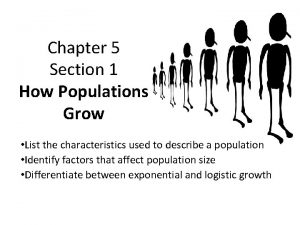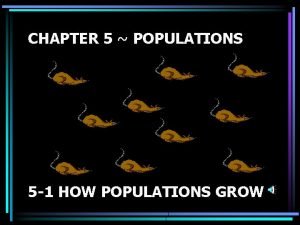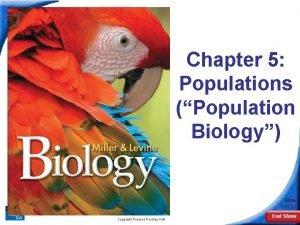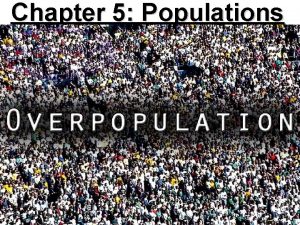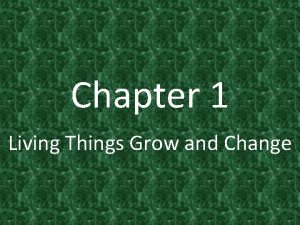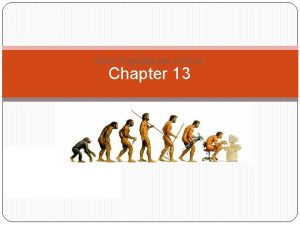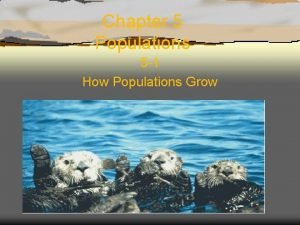Populations Chapter 16 How Populations Grow Change in










- Slides: 10

Populations Chapter 16

How Populations Grow • Change in one population causes change in another – Population: • All the individuals of a species that live together in 1 place at 1 time. • Balance must occur for life to be supported.

Three Key Features of Populations • Population Size: – The number of individuals in a population can affect the populations ability to survive. • Small populations are likely to go extinct • Population Density: – The number of individuals that live in a given area. • Ex. Los Banos Human Populations- 36, 211 • Dispersion: – The way the individuals of the population are arranged in the space.

Models to Explain Population Growth • Growth rate affects population size – Exponential Growth Curve: • The rate of the population growth stays the same, as a result the population size increases steadily. • Ex. J-shaped curve- Single celled bacteria • Resources affect population size – Logistic Model: • Exponential growth is limited by a densitydependent factor • Ex. S-shaped curve- 6 billion humans

Population Growth Model K is the carrying capacity

Rapidly Growing Populations • R-Strategists: – Grow exponentially when environmental conditions allow them to reproduce. • Density-independent • Ex. Bacteria, some plants, and many insects – – – Short life span Usually reproduce early in life Have many offspring Offspring mature rapidly Have no parental care

Slowly Growing Populations • K-Strategists: – Populations that grow slowly and have small population sizes. • Ex. Whales and Redwood Trees – Long life span – Few offspring – Slow maturing process – Reproduce late in life

How Populations Evolve • Hardy-Weinberg Principle: – The frequency of alleles in a population do not change unless evolutionary forces act on the populations. • Equation to predict genotype frequencies: – p² + 2 pq + q² = 1 – AA Aa aa

5 Principle Evolutionary Forces • 1. Mutation • 2. Gene Flow: – The movement of alleles into or out of a population. • 3. Nonrandom Mating: – Individuals that prefer to mate with others that live nearby or are their own phenotype • Ex. Male widowbirds • 4. Genetic Drift: – Random change in the allele frequency. • Ex. Cheetahs • 5. Natural Selection – Acts only on the phenotype

Natural Selection Changes Trait Distribution a) Normal distribution b) Directional Selection c) Stabilizing Selection
 Chapter 5 lesson 1 how populations grow answer key
Chapter 5 lesson 1 how populations grow answer key Chapter 5 lesson 1 how populations grow
Chapter 5 lesson 1 how populations grow Section 5-1 how populations grow
Section 5-1 how populations grow Population growth concept map answers
Population growth concept map answers Section 5-1 how populations grow
Section 5-1 how populations grow 5-1 how populations grow
5-1 how populations grow Change grow live barnet
Change grow live barnet Living things grow and change
Living things grow and change Think and grow rich chapter 10
Think and grow rich chapter 10 Chapter 16 evolution of populations vocabulary review
Chapter 16 evolution of populations vocabulary review Chapter 13 how populations evolve test
Chapter 13 how populations evolve test
